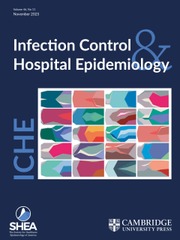Crossref Citations
This article has been cited by the following publications. This list is generated based on data provided by Crossref.
Nichols, Ronald Lee
1993.
Classification of the Surgical Wound: A Time for Reassessment and Simplification.
Infection Control & Hospital Epidemiology,
Vol. 14,
Issue. 5,
p.
253.
Medina-Cuadros, Marcelino
Sillero-Arenas, María
Martínez-Gallego, Gabriel
and
Delgado-Rodríguez, Miguel
1996.
Surgical wound infections diagnosed after discharge from hospital: epidemiologic differences with in-hospital infections.
American Journal of Infection Control,
Vol. 24,
Issue. 6,
p.
421.
Nichols, Ronald Lee
1996.
Surgical infections: Prevention and treatment—1965 to 1995.
The American Journal of Surgery,
Vol. 172,
Issue. 1,
p.
68.
van Griethuysen, A.J.A.
Rooijen, N.H.Spies-van
and
Hoogenboom-Verdegaal, A.M.M.
1996.
Surveillance of wound infections and a new theatre: unexpected lack of improvement.
Journal of Hospital Infection,
Vol. 34,
Issue. 2,
p.
99.
Rantala, Arto
Lehtonen, Olli-Pekka
and
Niinikoski, Juha
1997.
Alcohol abuse: A risk factor for surgical wound infections?.
American Journal of Infection Control,
Vol. 25,
Issue. 5,
p.
381.
Reichert, Magaly Cecília Franchini
Medeiros, Eduardo Alexandrino Servolo
and
Ferraz, Fernando Antonio Patriani
2002.
Hospital-acquired meningitis in patients undergoing craniotomy: Incidence, evolution, and risk factors.
American Journal of Infection Control,
Vol. 30,
Issue. 3,
p.
158.

